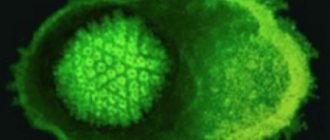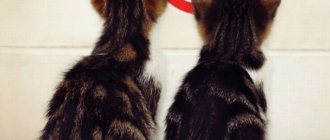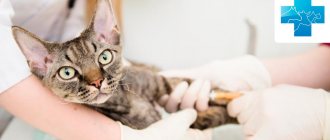Infectious disease of the upper respiratory tract. caused by a DNA herpes virus is called viral rhinotracheitis.
Herpesvirus infection in cats is a fairly common disease, characterized by damage to the mucous membrane lining the respiratory tract, discharge from the nasal cavity, inflammation of the trachea and bronchial tree. In advanced cases and with weak immunity in a cat, viral rhinotracheitis provokes pneumonia, as well as serious eye damage.
Any cat can become infected, regardless of age or breed. But herpesvirus infections are more common in kittens. When cats are kept in crowded conditions, the rhinotracheitis virus spreads quickly, affecting a large number of animals. This is especially noteworthy for nurseries.
What is feline herpes virus infection?
Herpesvirus infection of cats, or rhinotracheitis, is a real tragedy for the cattery. Due to its high contagiousness (infectiousness), it is quickly transmitted between animals, and crowded living conditions provoke the growth of the epidemic.
Pathogen
The causative agent of rhinotracheitis is the herpesvirus FHV-1. After penetration into the body, it begins active reproduction inside cells, causing their destruction and death.
The danger of the virus lies not only in its contagiousness, but also in its resistance to external factors. It can survive in the environment for several days, and its death occurs only when disinfectants are used.
Routes of infection
Not only an outdoor cat, but also a domestic one can become infected with herpesvirus. Transmission of infection occurs when:
- direct contact with infected animals or objects;
- an insect bite that came into contact with a sick cat;
- the birth of kittens from an infected mother or during breastfeeding.
The pathogen is released along with biological fluids (urine, tears, saliva), so the owner can easily bring it home on his shoes. For this reason, you should not let your guard down, even if your pet never goes outside and has no contact with other animals.
Incubation period
On average, the incubation period takes about 5 days. Despite the absence of symptoms, a sick cat is capable of transmitting the infection to other animals within a day after infection.
Epizootology
Under natural conditions, animals become infected mainly aerogenously. The source of the causative agent of herpes virus infection is sick and recovered cats, which secrete the virus for 9-19 months after recovery. The virus is released through nasal secretions, discharge from the eyes and genitals, milk, urine, feces, and semen. Transmission factors can include infected air, food, care items, and people who have had contact with sick animals. The efficiency of transmission also depends on the amount of virus released by the infecting animal, as well as the duration and proximity of contact. The virus appears in nasal and oropharyngeal secretions within 24 hours after infection and, as a rule, is actively excreted within 18-30 days. In the case of latent carriage, the virus is able to reactivate under the influence of factors that lower immunity (stress, pregnancy, lactation, use of corticosteroids, concomitant disease). Reactivation of the virus occurs, on average, 7-10 days after, for example, exposure to stress; the period of virus isolation in this case lasts from 3-4 to 14 days. Crowded housing, overheating, hypothermia and inadequate feeding of cats, and poor microclimate contribute to the spread of the disease.
Development mechanism
After entering the mucous membranes of the respiratory tract, the virus penetrates into epithelial cells, in which it multiplies. Subsequently, an inflammatory reaction occurs, first small and then more extensive areas of necrosis are formed on the surface of the mucous membrane. FHV-1 enters the blood, and against the background of viremia, the animal develops depression and fever. When the virus penetrates the placental and blood-brain barriers, damage occurs to the brain, placenta, uterus and fetus, leading to pregnancy pathology and stillbirth. The course of the disease is aggravated by mixed infection, when it occurs simultaneously with calicivirus infection and panleukopenia.
Symptoms and course
The incubation period is short - 2-17 days. The disease occurs acutely, subacutely and chronically. The most typical symptoms: lack of appetite, depression, fever, purulent conjunctivitis, keratitis, sometimes diarrhea (usually yellowish-green), ulceration of the oral cavity with profuse salivation, shortness of breath. The disease can be complicated by tracheitis, bronchitis, and in severe cases, pneumonia is possible. In acute cases, an increase in body temperature of up to 40° C or more is recorded in cats for 2-5 days. Then conjunctivitis and rhinitis develop. In the first days of the disease, profuse serous-mucous discharge from the nose is noted, turning into serous-fibrinous or fibrinous-purulent. Animals develop shortness of breath, profuse salivation, hoarseness, cough, and pain in the larynx. If the digestive tract is affected, vomiting and diarrhea are observed. The virus is noted to be tropic to the growth sites of skeletal bones, including the nasal turbinates, which can lead to chronic rhinitis and sinusitis in recovered cats. Due to the significant tropism of the virus specifically for the conjunctival epithelium, the most common are ocular lesions, characterized by bilateral conjunctivitis and blepharitis. Significantly more serious eye pathologies occur in those cats that have previously had a herpes virus infection. While there is evidence that reinfection with a different strain of FHV-1 may occur, it is more likely that eye infections in adult cats result from reactivation of latent virus. Corneal lesions associated with recurrent FHV-1 infection manifest as several different syndromes: epithelial ulceration, stromal keratitis, symblepharon, entropion. The disease lasts on average 7-28 days. With a normal level of immunity and the absence of complications, secondary bacterial microflora, clinical signs weaken by 10-14 days, completely disappearing by the fourth week from the moment of illness. In adult cats, death is relatively rare as a result of dehydration, as well as secondary bacterial infection, which can lead to bronchopneumonia with subsequent development of pulmonary edema. The infection is severe in cats with concomitant viral diseases: calicivirus or coronavirus infection (infectious peritonitis), leukemia or immunodeficiency. Most cats that have suffered an acute form of the disease become carriers of the virus.
Causes of the disease
Immediately after infection, the disease occurs in a hidden (latent) form. Activation of the pathogen occurs with a sharp decrease in immunity. This occurs during pregnancy, severe stress, concomitant diseases, lack of vitamins, hypothermia and overheating of the body.
Herpes virus infection in kittens is more severe than in adult animals and can be fatal. Also at risk are Persian cats, who are vulnerable to the disease as a result of their breed characteristics.
Symptoms of herpesvirus in cats
The first warning signs appear immediately after the incubation period. These include:
- difficulty breathing and cough;
- inflammation and swelling of the larynx;
- frequent sneezing and profuse salivation;
- sores on the tongue and lips;
- purulent nasal discharge;
- conjunctivitis;
- the appearance of a third eyelid or film on the eye;
- redness and swelling of mucous membranes;
- mucous vomiting;
- temperature rise to 40°C.
The sick person becomes apathetic and loses appetite. When eating food and water, he arches his neck and tilts his head to the side to ease the pain in his throat when swallowing.
Symptoms of the disease
They do not appear immediately. The duration of the incubation period is 3-8 days. Then the first signs of the disease appear:
- decreased or complete lack of appetite;
- lethargy;
- disturbances of the gastrointestinal tract in the form of diarrhea or vomiting;
- shortness of breath;
- mouth ulcers;
- conjunctivitis;
- increase in body temperature.
Advanced infection brings suffering to the animal
Classification by type
Symptoms and treatment for herpes in cats vary depending on the type. Depending on the severity of the symptoms and the speed of development, the infection is divided into 3 types:
- Acute
. It is accompanied by all the described symptoms, so it can be diagnosed quite quickly. Without timely treatment it becomes chronic.
- Chronic
. It is characterized by the appearance of inflammation on the skin, as well as alternating remissions and relapses. It can last for years, gradually disrupting the functioning of the central nervous system. Over time, the animal develops tremors in the limbs and manege movements, that is, an irresistible desire to walk in a circle. This type of pathology is fraught with ulcerative colitis and blindness.
- Latent
. Characterized by the absence of symptoms. It can become acute when exposed to certain factors that reduce the body’s defenses.
When treating the acute form, recovery occurs within 1-2 weeks. If, at the time of contacting the veterinary clinic, rhinotracheitis has become chronic, then it will take much longer.
After recovery, the pet acts as a carrier for up to 3-6 months, since the pathogen remains in its secretory glands. Under certain factors, he himself may become ill if the virus enters the active phase again.
How to help your pet recover faster
Also during treatment
It will be necessary
to change the
cat’s diet, which means that the pet will need to be given either liquid or semi-liquid food. Sometimes the animal is reluctant to accept such a change in its established diet, and in order to help it, you will have to literally force it at first.
To help the animal recover even faster, during the treatment process, antibacterial drugs can also be used in parallel along with immunomodulatory drugs, that is, those that will simultaneously increase the immune system of the animal’s entire body. In our veterinary center you can get all the necessary help, as well as consultation with an ophthalmologist.
Our veterinarian provides all the necessary services for treatment, examination and assistance to animals. You can always count on us, our help and the high qualifications of our team of veterinarians. Moreover, you, as an animal owner, should always remember that trying to cure a cat with little knowledge in this area is fraught with consequences.
Provide much-needed love, care and support through our team to your pet. We are always responsible for those we have tamed! We are always open to you and ready to advise on any questions you may have. Our veterinary center works for you and for your sake, because otherwise, why would we create it?! We will always provide due attention to your pet. For we understand how important it is for him to be healthy, to be happy himself and to continue to delight you with his shining and healthy eyes in the future.
Without a doubt, we understand that today people value their time very much, which is why our veterinary center provides such a service as a veterinarian visiting your home. This service is very convenient for residents of our metropolis, and your animal will receive even faster and more significant assistance. We do everything sterilely, having with us all the proper list of documents.
Diagnostic features
It is not possible to cure the disease at home. Do not wait for complications to appear and contact the veterinary clinic at the first signs of discomfort.
Symptoms of rhinotracheitis are similar to other infections, so before starting treatment it is important to determine the actual pathogen. What symptoms are NOT characteristic of herpesvirus:
- intense inflammation of the gums, a large number of ulcers and lameness - the likelihood of calcivirosis;
- absence of conjunctivitis and preservation of appetite – bordetellosis;
- alternating eye damage - chlamydia;
- very loose stools with a pungent odor - distemper.
At the appointment, the veterinarian carefully examines the mustachioed patient and collects anamnesis, clarifying the clinical picture from the owner. In addition to the examination, to make a diagnosis you will need:
- general and biochemical blood tests that determine the general condition of the body;
- antibody test and PCR study confirming the presence of the virus and its type;
- smears taken from the eyes, pharynx and nasal sinuses, helping to exclude pathologies with similar symptoms.
After receiving all the results, the veterinarian determines the form of the disease and selects a treatment plan. Please note that it is prohibited to stop taking medications until you receive appropriate instructions from your doctor! Otherwise, the pathology may become chronic.
Diagnosis
As soon as the first signs of illness appear, the cat should be immediately taken to a veterinary clinic. Herpes rhinotracheitis has symptoms similar to calcivirus, which also affects the upper respiratory tract. To clarify the diagnosis, the clinic does a blood test. Also, the veterinarian, in conversation with the owner, collects the necessary data, conducts a visual and tactile examination, and takes scrapings of the mucous membranes of the throat, nose and eyes. In addition to calcivirus, it is also necessary to exclude infection with bordetellosis and chlamydia, which have similar symptoms.
Treatment methods
Treatment of herpesvirus in cats is carried out at home under the supervision of a veterinarian. The first improvements are noted within a couple of days from the start of taking the prescribed medications.
Drug therapy
The main goal of therapy is to increase immunity. Thanks to this, the body copes with the virus on its own. The sick animal is prescribed:
- antibiotics and sulfonamides that eliminate concomitant infections;
- anti-inflammatory, antipyretic, expectorant and antiemetic agents;
- intramuscular injections of vitamins A, B and C;
- immunomodulators;
- medications for rhinitis, conjunctivitis and laryngeal diseases.
Glucose drips are given for severe dehydration and exhaustion. In such cases, the mustachioed patient is placed in a hospital until his condition normalizes and his previous appetite returns. Another option is for a nurse to come to the sick person’s home every day.
Procedures
When treating herpes virus in cats, special attention is paid to ulcers on the cornea. Further ulceration is fraught with loss of vision, so it is very important to prevent the pathological process before the situation worsens.
To eliminate ulcers, use antiviral ointment acyclovir and antimicrobial ointment tetracycline. The surface of the eyes is treated 5-6 times a day for a week.
Additionally, the affected areas are washed with chamomile decoction and miramistin. During the procedure, it is recommended to wrap your pet tightly in a towel or blanket. This will prevent injury to the mucous membrane or your hands when pulling out an unhappy animal. After immobilizing your mustachioed pet, proceed to the following steps:
- Take a sterile cotton pad and soak it in the prepared solution. Remember that you need to use a different disc for each eye.
- Gently wipe the affected areas and surrounding area. If large drops flow abundantly from the disk, squeeze it out to remove excess.
- Repeat the procedure several times and let the solution absorb. If necessary, apply acyclovir or tetracycline to the eyelid and massage it lightly. After this, the cat can be released. Perform the procedure at least 3 times a day.
For severe coughing and other breathing problems, steam inhalation may be required. At home, warm and moist air that appears in the bathroom after taking a hot shower or filling a bath is suitable for this. To get a positive effect from the procedure, just keep your pet in a tightly closed bathroom for 10-15 minutes.
Forecasts
Forecasts are usually positive. If the animal is treated promptly in accordance with the veterinarian's recommendations, there will be no threat to life. Only weakened or untreated pets die.
After the cat has recovered, it will be a carrier of the herpes virus for about three months. Its cells are found in urine, saliva, mucous membranes of the eyes and nose. This disease cannot be completely cured. Herpesvirus in cats goes into a latent form and remains in the body. Repeated exacerbation occurs under the influence of various stress factors.
One of the complications is blindness or scarring of the eyes
Animal care
During drug therapy, the pet should be isolated from other cats for 2-3 weeks. During this time, healthy individuals must be vaccinated to prevent further spread of the herpes virus.
In addition to taking medications, the patient will need comfortable living conditions and a nutritious diet. To destroy the virus from surfaces in the house, steam treatment is carried out. It is recommended to clean the tray and food bowls belonging to the infected person with a chlorine solution, and throw them away after treatment.
Protect your pet from stress and drafts. Place it in a warm and quiet place, protected from intrusion by other inhabitants. Anxiety has a negative impact on well-being and can cause a relapse.
Bowls for food and water, as well as the toilet should be located close to the bed. Thanks to the proximity of these objects, the cat will not have to waste energy moving around the apartment. The saved strength will help in the fight against the virus.
Diet and nutrition
A weakened body needs nutrients, but a stuffy nose without smell and a sore throat seriously complicate feeding. You can stimulate your appetite with the help of wet canned food - their strong and tasty smell is much more attractive than dry food. In the future, the granules can be returned by choosing a brand with good calorie content.
When feeding naturally, use light meals that do not injure the mucous membranes. The diet should include:
- boiled chicken or beef mince;
- raw quail eggs;
- watery porridge;
- unrich meat broths;
- pureed vegetables that have undergone heat treatment.
Serve food often (4-5 times a day), but in small portions. This will eliminate prolonged fasting and heaviness in the stomach. The temperature of the food should be at room temperature.
Don't forget about water. It should be changed twice a day. If you do not have this option, purchase a drinking fountain with automatic filtration.
Diet
If the cat has been fed only dry food all the time, for the period of treatment it is better to switch it to wet food from the same manufacturer or select a special line of food rich in vitamins and minerals. This will help restore immunity faster. If a furry patient has a natural diet, his menu should be supplemented with the following dishes:
- liquid soup;
- porridge;
- meat puree (chicken and beef);
- pate processed with boiling water;
- boiled fish;
- vegetable puree.
Such nutrition will replenish the body with essential vitamins.
It is necessary to change the water two to three times a day; it must be bottled or filtered. Tap water should not be given. Until the animal recovers, you should not give it cat treats from pet stores. Eliminate food from the host’s table completely, this will only harm your health.
The key to a cat’s health is a timely visit to the veterinarian
Can a person become infected?
The herpesvirus FHV-1 is dangerous only for the cat family. It cannot be infected by four-legged animals of other species or humans, so you should not be afraid of the sick person and avoid close contacts.
Despite this, it is worth considering that infection works in the opposite direction. A dog or its owner walking outside can bring the virus into the house on their paws and shoes. For this reason, it is very important not to neglect prevention and vaccinate your pet upon reaching the appropriate age.
Vaccination
The vaccine against herpes virus infection is considered the main method of prevention.
Additional preventive measures include:
- creating living conditions in which the cat will not experience stress. You cannot raise your voice at an animal. There should be no violent quarrels and disputes in the family. It is better to travel to the veterinary clinic by car or call a specialist at home;
- if the owner walks his pet on the street, contact with other animals should be limited as much as possible;
- before mating, the future partner must be tested for the presence of the virus;
- if a sick animal appears in the house, it must be isolated so that healthy animals do not become infected;
- the cat should be examined regularly by a veterinarian;
- it is necessary to follow a proper diet;
- If your furry friend “sits” mainly on a natural diet, you need to consult a veterinarian so that your pet can be prescribed a vitamin and mineral complex.
Even if the cat has been vaccinated, there is no guarantee that he will not become infected with a herpes virus infection in the nursery or in other places where he communicates with his fellow cats. In this case, it will not show any symptoms, but the animal will still be a carrier of the virus. However, a vaccinated animal is spared from severe complications of this disease. Also, the vaccine will not protect a cat that is already a carrier of the virus, but the risk of spreading it to other animals will be much lower.
It is important to follow all necessary preventive measures
Prognosis and complications
Herpes in kittens causes death in 20% of cases. Also at risk are pets with an advanced form of the pathology. Weakened animals die from acute dehydration or bronchial pneumonia caused by secondary infection. In all other cases, a positive prognosis is given.
If treatment is delayed, the disease develops into a chronic form, fraught with the following complications:
- inflammatory processes in the lungs, bronchi, trachea and sinuses;
- dry eye syndrome and vision loss;
- miscarriages or stillborn kittens;
- intestinal atony, accompanied by constant constipation;
- pathologies of the central nervous system (gait disturbance, muscle spasms);
- deep ulcers with scarring and subsequent death of corneal tissue;
- destruction of the jaw bone;
- leukemia, or blood cancer;
- viral immunodeficiency.
It is much safer to vaccinate your pet against the virus in advance with a special vaccine that provides passive immunity against the pathogen. Although vaccination does not guarantee one hundred percent protection against infection, it significantly alleviates the course of the disease if it does appear.










